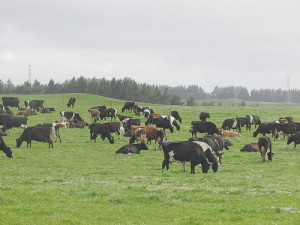Reserve Bank rules bleeding farmers dry - Feds
There are calls for the Reserve Bank to drop its banking capital rules, which Federated Farmers says is costing farmers a fortune.
 The agricultural sector accounts for 14% of all bank lending with the dairy sector making up 68% of this figure.
The agricultural sector accounts for 14% of all bank lending with the dairy sector making up 68% of this figure.
Banks may increasingly lose patience with farms with very high cost structures and very high debt burdens, warns Chris Bloor, financial systems analyst at the Reserve Bank of New Zealand.
Bloor told the recent New Zealand Institute of Primary Industry Management conference at Lincoln that $5 billion in extra debt was taken on by the dairy industry between 2014 and 2016.
Expressed in terms of debt per kilogram of milksolids produced, and using $30 debt/kg MS as a benchmark, Bloor said that in 2014, 26% of the debt in the industry was to farms with debt around that mark, but that figure is now 44%.
“That’s a significant increase of the very highly indebted,” he said.
When debt servicing is added to working expenses, the highly indebted farms tend to have higher cost structures, and also tend to have less fat to cut should there be another downturn or a rise in interest rates.
Bloor calculated that farms with more than $40 debt/kg MS would need a break-even milk price of about $5.50. However, just a 1% rise in interest rates would push these farms towards needing a break-even price of $6.
“Banks will become increasingly uncomfortable with some of these farms,” he says.
Bloor’s opening remarks were that the Reserve Bank had not asked the commercial banks to do anything about the dairy industry, and how they handle sector debt is up to them. He says the banks are starting to tighten all lending, not just agricultural.
While he identified both the 2008 global credit crunch and the recent dairy price downtown as factors in farm debt, Bloor said farmers’ debt had been increasingly markedly for at least 20 years.
In the 1990s a typical farm had debt of about 100% of their annual income. Now debt averages about 275% – about 200% for sheep and beef farms and about 350% for dairy.
“There is probably no other sector in the NZ economy with as much debt as the dairy sector.”
Bloor says this bothers the Reserve Bank because agricultural sector debt is a large portion of bank balance sheets: the agricultural sector accounts for 14% of lending -- 68% of it dairy debt.
He added that farm income volatility makes that debt more risky than household or business debt.
“Over the last 10 years we’ve seen commodity prices go all over the place. We’ve had very good years in the dairy sector in particular and we’ve just come through two very bad years.”
Bloor says strong dairy production growth in Europe between 2013 and 2016 was seen by the Reserve Bank as the big downward driver of prices; not until European production eased during 2016 did prices start to recover.
Bankers worked with industry
The Reserve Bank has worked closely with DairyNZ to understand the nature of indebtedness and profitability in the dairy sector, the bank’s financial systems analyst Chris Bloor says.
Using DairyNZ figures for farm profit from the 2015-16 season, it was striking how much variation there was.
“We talk about it being a tough time for the industry as a whole, but some farms were still making money in the depths of this downturn,” said Bloor.
“However, on the whole about 60% of dairy farmers were losing money in the 2015-16 season.”
Bloor said the vast bulk of farmers are now making profits again but some are still not.
“Talk about bank behaviour and how they’re going to respond, they’re going to be looking at farms at the bottom end of this distribution and saying ‘What are you doing, guys?
“This does not look sustainable. Can you actually continue to service debt?’ ”
Bloor says the Reserve Bank has done a lot of with DairyNZ trying to understand how the sector would handle low payouts, but the scenarios generally are not as bad as feared, because of several factors, the first being that the milk price recovery has been “very timely” and there has been a huge amount of cost cutting.
However, a “really big factor” has been bank behaviour. “We went through this period of saying to banks ‘Don’t panic, take the long term view here. You should not be foreclosing on farms if they’re going to be sustainable in the long run.’ ”
However, it all means that balance sheets are more stretched now than a couple of years ago.
Bloor said farmers will probably see less patience from their banks in future.
Horticulture New Zealand (HortNZ) says a new report projects strong export growth for New Zealand's horticulture sector highlights the industry's increasing contribution to the national economy.
Fonterra shareholders say they will be keeping an eye on their co-operative's performance after the sale of its consumer businesses.
T&G Global says its 2025 New Zealand apple season has delivered higher returns for growers, reflecting strong global consumer demand and pricing across its Envy and Jazz apple brands.
New Zealand's primary sector is set to reach a record $62 billion in food and fibre exports next year.
A new levying body, currently with the working title of NZWool, has been proposed to secure the future of New Zealand's strong wool sector.
The most talked about, economically transformational pieces of legislation in a generation have finally begun their journey into the statute books.

OPINION: Federated Farmers has launched a new campaign, swapping ‘The Twelve Days of Christmas’ for ‘The Twelve Pests of Christmas’ to…
OPINION: It used to be that the National Fieldays attracted brickbats for being officious clipboard carriers, while the regional, farmer-run field…